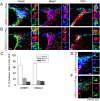Identification of molecular markers distinguishing adult neural stem cells in the subventricular and subcallosal zones
- PMID: 30460064
- PMCID: PMC6138335
- DOI: 10.1080/19768354.2017.1324522
Identification of molecular markers distinguishing adult neural stem cells in the subventricular and subcallosal zones
Abstract
Neural stem cells (NSCs) in the adult subventricular zone (SVZ) are regionally specified and have distinct molecular gene expression signatures. Recently, we identified the subcallosal zone (SCZ) as a novel brain region where adult NSCs maintain and spontaneously produce neuroblasts. In an attempt to isolate genes specifically expressed in the SCZ or SVZ, microarray analyses of their differentially expressing transcripts were done. The comparison between neurospheres generated from SVZ and SCZ revealed differential expression >1.5-fold in two groups in only 83 genes, representing <0.03% of the genes examined, suggesting that these two populations are largely similar. The differential expression patterns SCZ and SVZ genes were confirmed by RT-PCR and Western blots. The selective expressions of two genes (CRBP1, HMGA1) in SVZ-NSCs were further confirmed by immunohistochemistry. These molecular markers could be useful for further molecular and cellular characterization of NSCs.
Keywords: CRBP1; HMGA1; Subventricular zone; ZIC2; adult neural stem cell; microarray; subcallosal zone.
Figures



Similar articles
-
Postnatal Development of Subcallosal Zone Following Suppression of Programmed Cell Death in Bax-deficient Mice.Dev Reprod. 2013 Sep;17(3):179-86. doi: 10.12717/DR.2013.17.3.179. Dev Reprod. 2013. PMID: 25949132 Free PMC article.
-
Age-dependent changes in the subcallosal zone neurogenesis of mice.Neurochem Int. 2012 Nov;61(6):879-84. doi: 10.1016/j.neuint.2012.02.027. Epub 2012 Mar 6. Neurochem Int. 2012. PMID: 22417727
-
In vitro characterization of subventricular zone isolated neural stem cells, from adult monkey and rat brain.Mol Biol Rep. 2021 Feb;48(2):1311-1321. doi: 10.1007/s11033-021-06201-7. Epub 2021 Feb 10. Mol Biol Rep. 2021. PMID: 33566222
-
The Adult Ventricular-Subventricular Zone (V-SVZ) and Olfactory Bulb (OB) Neurogenesis.Cold Spring Harb Perspect Biol. 2016 May 2;8(5):a018820. doi: 10.1101/cshperspect.a018820. Cold Spring Harb Perspect Biol. 2016. PMID: 27048191 Free PMC article. Review.
-
Astrocyte and Oligodendrocyte Responses From the Subventricular Zone After Injury.Front Cell Neurosci. 2021 Dec 24;15:797553. doi: 10.3389/fncel.2021.797553. eCollection 2021. Front Cell Neurosci. 2021. PMID: 35002630 Free PMC article. Review.
Cited by
-
Rapid and Efficient Generation of Myelinating Human Oligodendrocytes in Organoids.Front Cell Neurosci. 2021 Mar 17;15:631548. doi: 10.3389/fncel.2021.631548. eCollection 2021. Front Cell Neurosci. 2021. PMID: 33815061 Free PMC article.
-
Transcriptional Signature of Valproic Acid-Induced Neural Tube Defects in Human Spinal Cord Organoids.Int J Stem Cells. 2023 Nov 30;16(4):385-393. doi: 10.15283/ijsc23012. Epub 2023 Aug 30. Int J Stem Cells. 2023. PMID: 37643760 Free PMC article.
-
Neural Epidermal Growth Factor-Like Like Protein 2 Is Expressed in Human Oligodendroglial Cell Types.Front Cell Dev Biol. 2022 Feb 21;10:803061. doi: 10.3389/fcell.2022.803061. eCollection 2022. Front Cell Dev Biol. 2022. PMID: 35265611 Free PMC article.
-
Gender-specific effects of transthyretin on neural stem cell fate in the subventricular zone of the adult mouse.Sci Rep. 2019 Dec 23;9(1):19689. doi: 10.1038/s41598-019-56156-w. Sci Rep. 2019. PMID: 31873158 Free PMC article.
-
The ventricular-subventricular, subgranular and subcallosal zones: three niches of neural stem cells in the postnatal brain.Exp Brain Res. 2023 Jun;241(6):1463-1470. doi: 10.1007/s00221-023-06621-w. Epub 2023 Apr 21. Exp Brain Res. 2023. PMID: 37083843 Review.
References
-
- Alvarez-Buylla A, Kohwi M, Nguyen T, Merkle F.. 2008. The heterogeneity of adult neural stem cells and the emerging complexity of their niche. Proceedings of the Cold Spring Harbor symposia on quantitative biology. New York: Cold Spring Harbor Laboratory Press. - PubMed
-
- Brill MS, Snapyan M, Wohlfrom H, Ninkovic J, Jawerka M, Mastick GS, Ashery-Padan R, Saghatelyan A, Berninger B, Götz M.. 2008. A dlx2-and pax6-dependent transcriptional code for periglomerular neuron specification in the adult olfactory bulb. J Neurosci. 28:6439–6452. doi: 10.1523/JNEUROSCI.0700-08.2008 - DOI - PMC - PubMed
LinkOut - more resources
Full Text Sources
